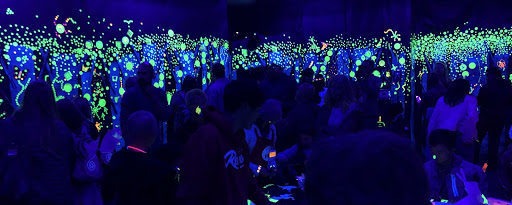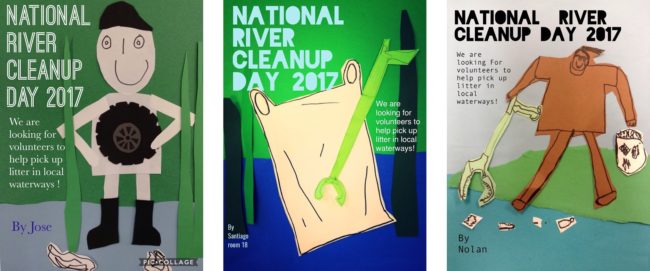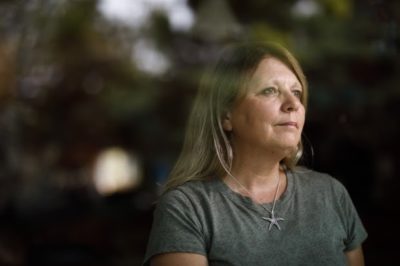The necessity to foster a lasting interest and care for the natural world is a priority for me. Through participatory installations, projects and workshops, my work as an eco-artist, a teaching artist, and a STEAM educator, invites the community to re-engage with nature and understand that human society is only one element of the interconnected living world. My work aims to motivate people to think about how our actions and choices impact our environment and how we reduce that impact.
To achieve a sustainable future, environmental literacy should be foundational in what students learn today, starting at an early age. I am baffled that it is not on the list of skills for the 21st Century. The Partnership for 21st Century Skills mentions only that schools must “promote understanding of academic content at much higher levels by weaving 21st century … themes into core subjects”, including environmental literacy.
Students need to make a real connection between natural resources, the infrastructure we live in, the things we buy, the tools we use, and the energy it all demands. For that, we need to connect education to the Earth System for students to understand why it is so essential to change the way we live in a time of climate crisis. Art and science projects are an excellent way to convey important ideas and to create visuals that make a lasting impression. And that is what I am doing.
Through contracts with non-profit organizations and through my own contracts, I meet a lot of different students. I teach STEAM programs to K-5 students in Campbell, California and to grades 6 through 8 students in East San Jose. Students are from various backgrounds, with different levels of school and family support. But all students, no matter their level of knowledge about the environment, are eager to engage in the projects I propose.
Topics I introduce students to address include pollution, sustainability, resources, and biodiversity. One way to help students better understand these topics is to connect them to the region where they live.“From Our Watershed to the Ocean” is an ensemble of hands-on projects I developed for K to 8 students that focuses on how human activity impacts the Bay Area. When I meet students for the first time, I show them a satellite view of the Bay Area and ask, “Where is the ocean, the San Francisco Bay? Why is it grey all around the bay? Can you point to the place where you live?” I bring a large bag of trash I collected during a cleanup around the Bay and empty it in the classroom. It is a very effective way to start a conversation about plastic pollution. I often ask a specialist from a water treatment facility to join us to explain where the water we use comes from, where it goes after we use it, and how human activity pollutes the watershed. Whether kindergarteners or older students, I approach them with the same style and questions because the questions are not complex, but they are thought-provoking for all ages. And through these exercises, the issues become more relatable to students.

My teaching projects employ a wide array of art and design techniques:
- Digital posters about River Cleanup Day, Coastal Cleanup Day
- Mini mobiles with plastic trash collected around the bay tagged with actions that can be taken (Sign up for a cleanup! for example)
- Data visualization of the water it takes to grow different types of food
- Automata about pollinators
- Endangered marine species shadow boxes
- Short videos of shadow puppet plays about the consequences of fishing techniques on marine ecosystems.

The start of a project is always a great opportunity for students to think about the use of resources, the notion of limited resources, and biocapacity limits. I ask the students, “Look around you. Where do you think the materials to make all the things you see come from?” They usually have no comprehension that the materials for the tables, carpets, chairs, whiteboard, shelving, pencils, markers — everything they use — came from mountains, oceans, lakes, rivers, forests, deserts, animals, or any combination of these. They simply don’t see the connection to nature.
We trace the journey of a particular material or tool the students use, from the natural resources to their table. For example, if I ask them what a pair of scissors is made of, they can tell it is metal and plastic. But they do not know where the metal comes from, and that it can take an array of different minerals, sometimes mined in different places, to make a specific metal. They learn that there is a complex story about nature behind a seemingly simple tool, which includes the use of natural resources (limited or renewable), machinery, transportation, and energy. When I ask them the origin of plastic, they have all sorts of hypotheses, especially the younger students. When they learn that the making of plastic involves pumping plankton that turned into oil over millions of years, it takes some time for them to comprehend that most plastics come from an ancient organic matter. They begin to pay more attention. And through these exercises, students begin to think about things like single-use plastic, and how bizarre it is to use a limited resource to make objects that we use only once, and which will likely end up polluting our oceans.
Over time, I have changed how I view my art and its impact on the environment. In the past, I typically bought canvas, acrylic paint, and various mediums. Today, my work is mostly made of low-impact materials, such as cardboard, paper, cardstock, and reclaimed wood, to name just a few. I participate in beach and river cleanups with my family and use the plastic I find in my art installations and workshops. My shows consist of installations intentionally designed for low-impact, either packing down to a few, small boxes or simply being recycled in the end.

I find that people have a more memorable experience if they learn through making, especially if the emotion creates beautiful memories. Through large-scale, participatory installations, I engage the public to participate and reflect:
- Plankton invites participants to add to the plankton wall and learn that we depend on plankton as much as on forests.
- Species Encounter: Dive in! is a large-scale shadow theatre event about the ocean. Participants animate shapes of endangered marine species, plankton, extinct marine species, and can create their own.
- Bio-ink Plankton Cloud is a permanent installation made with the bio-ink grown by a team of scientists of the Bio Tinkering Lab. The Tech members were invited to create mini ‘plankton soups’, with bio-ink and stamps.
- Sip. Do not gulp. addressed the history of water usage in the Santa Clara Valley. Visitors could add their thoughts about water scarcity on a large painted mural.
I am grateful to have had so many opportunities to work with Bay Area communities on art and science projects that are relevant in today’s climate crisis. I am motivated because I see a need for the public to make sense of what is happening. As an engaged artist, I want to tell people how to take action. But there are concerns I still have yet to address through my work, such as the impact of the meat and dairy industry on the environment.
Over my last year of reading, I have learned about the risk of systemic collapse, which has made me realize that the situation is much worse than I thought. Books by Pablo Servigne and Raphaël Stevens, and talks given by Jean-Marc Jancovici, Vincent Mignerot, Gael Giraud, Aurelien Barreau, Cyril Dion, Arthur Keller have helped me to see that the human predicament is the biggest challenge that we, as a species, have ever faced. I need to find ways to talk about this to my students through projects and art installations, including the notion of resilience. We may still have time to shift the paradigm, and I will be focusing my work on this urgency.
Photos:


 Michele is an eco-artist and arts educator, focusing on the impact human activities have on the environment. As an educator, she works with K-8 students in various settings and develops a curriculum that integrates visual arts and science. Originally from France, she lives in the San Francisco Bay Area.
Michele is an eco-artist and arts educator, focusing on the impact human activities have on the environment. As an educator, she works with K-8 students in various settings and develops a curriculum that integrates visual arts and science. Originally from France, she lives in the San Francisco Bay Area.
Michele’s website: www.micheleguieu.com
Twitter: @micheleguieu
Instagram: @micheleguieu
The MAHB Blog is a venture of the Millennium Alliance for Humanity and the Biosphere. Questions should be directed to joan@mahbonline.org.

